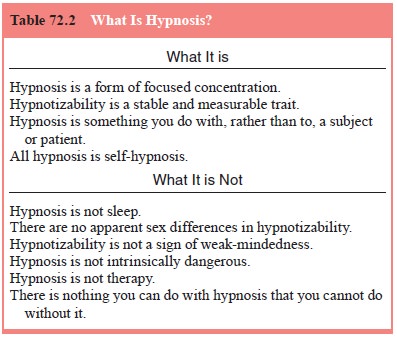Chapter: Essentials of Psychiatry: Hypnosis
Hypnosis: What It is and What It is Not
Hypnosis:
What It is and What It is Not
Several
principles provide guidance for the use of hypnosis in medicine and psychiatry.
We attempt to clarify some of the myths and misconceptions about hypnosis by
establishing what hypno-sis is and what it is not (Table 72.2).

Hypnotizability is a Stable and Measurable Trait
Not everyone is hypnotizable. Hypnotizability, or hypnotic capacity varies throughout the population. About 75% of the population has some usable hypnotic capacity; of these, about 10% are highly hypnotizable. This means that about one of four adults has no usable hypnotic capacity (Spiegel and Spiegel, 1978). It is advantageous to determine this early and encourage those with the ability to use it; other treatment modalities are of-fered to those who are not hypnotizable.
Hypnosis is Something You Do with, Not Something You Do to, a Subject or Patient
A
therapist inducing hypnosis is in the position of the Socratic teacher, helping
students discover what they already know. A useful metaphor to share with
subjects is that of a coach. A correctly performed hypnotic induction allows
the patient and physician to assess and explore the patient’s hypnotic
capac-ity or lack of it, just as a trainer assesses the athlete’s natural
capacities and then attempts to maximize them. This approach tends to minimize
power struggles between the physician and the patient. For example, there is
less chance of misinterpret-ing a patient’s inability to experience a hypnotic
trance as resistance.
All Hypnosis is Self-hypnosis
The
therapist helps the patient use his or her own hypnotic ca-pacity to undergo a
trance state. Helping patients to understand the degree of control they have
over their mental processes is a good way to foster mastery and control. By
doing this, patients may be able to comprehend the extent to which the
unconscious use of their hypnotic abilities may create or contribute to their
psychiatric symptoms, as in the case of dissociative disorders (Bliss, 1980,
1984; Spiegel, 1974; Spiegel and Fink, 1979). Simi-larly, hypnosis may help
patients understand how certain physi-cal symptoms may have unconscious
etiological factors, as in the case of conversion phenomena (i.e., psychogenic
blindness, pseu-doseizures) or psychosomatic conditions (i.e., asthma,
headache) (Maldonado and Spiegel, 2000).
There are no Apparent Sex Differences in Hypnotizability
Men and
women are equally hypnotizable (Hilgard, 1965; Stern et al., 1979).
Hypnosis is Not Sleep
The
hypnotized individual is not asleep but rather awake and alert. To an outside observer,
hypnotized individuals may appear asleep owing to their apparent lack of
responsiveness to the en-vironment. This is due to their intense absorption and
concentra-tion on their internal experience, rather than due to their lack of
will.
Hypnotizability is Not a Sign of Weak-mindedness
We know
that a hypnotic trance requires an intact capacity for focused concentration.
If anything, high hypnotizability is as-sociated with the absence of serious
psychotic and neurological disorders (Lavoie and Sabourin, 1980; Pettinati,
1982; Spiegel et al., 1982).
Hypnosis is Not Intrinsically Dangerous
For the
most part, it is a benign process. The same cognitive flexibility that allows
patients to enter the trance facilitates their exit from it with clear structure
and support from the thera-pist. The dangers of hypnosis lay not in the process
itself but in how it is used. There are few contraindications for the use of
hypnosis. A schizophrenic patient may incorporate an attempt at inducing
hypnosis into a delusional system. A severely de-pressed individual may
interpret a failure to benefit from hyp-nosis as further evidence of little
self-worth. These problems can be avoided in part by use of hypnotizability
testing at the beginning of the intervention. The most serious problem involves
possible effects of hypnosis on memory.
Hypnosis is Not Therapy
Entry
into a hypnotic state does not have any therapeutic effects of its own,
although many find it pleasant and relaxing. Therapeutic change comes not from
the state itself but from what happens during it. In this regard, hypnosis is
not a treatment itself but rather a facilitator of a variety of treatment
strategies. The state of intense concentration elicited in hypnosis can
facilitate attention to a variety of strategies that enhance control over
somatic function, reduce pain, allow the recovery and restructuring of
memories, elicit the reproduction and control of conversion symptoms or fugue
episodes, and provide control of dissociated states.
There is Nothing You can Do with Hypnosis that You cannot Do Without it
As an
adjuvant to therapy, hypnosis may help speed the process by which information
can be accessed and processed because of its ability to heighten concentration
and focus attention; however, it is not a treatment in and of itself.
Related Topics